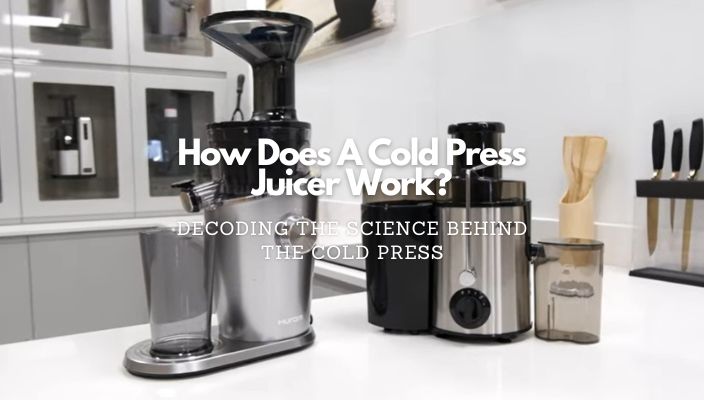Juicing has become a lifestyle trend, and for a good reason. But not all juicers are created equal. If you’re wondering how a cold press juicer works and why it’s all the rage, you’re not alone. Cold press juicers, also known as masticating juicers, have taken over kitchens and health bars because of their ability to deliver nutrient-packed juice that tastes fresh and vibrant.
So, what’s the magic behind it? Let’s peel back the layers and squeeze out the truth.
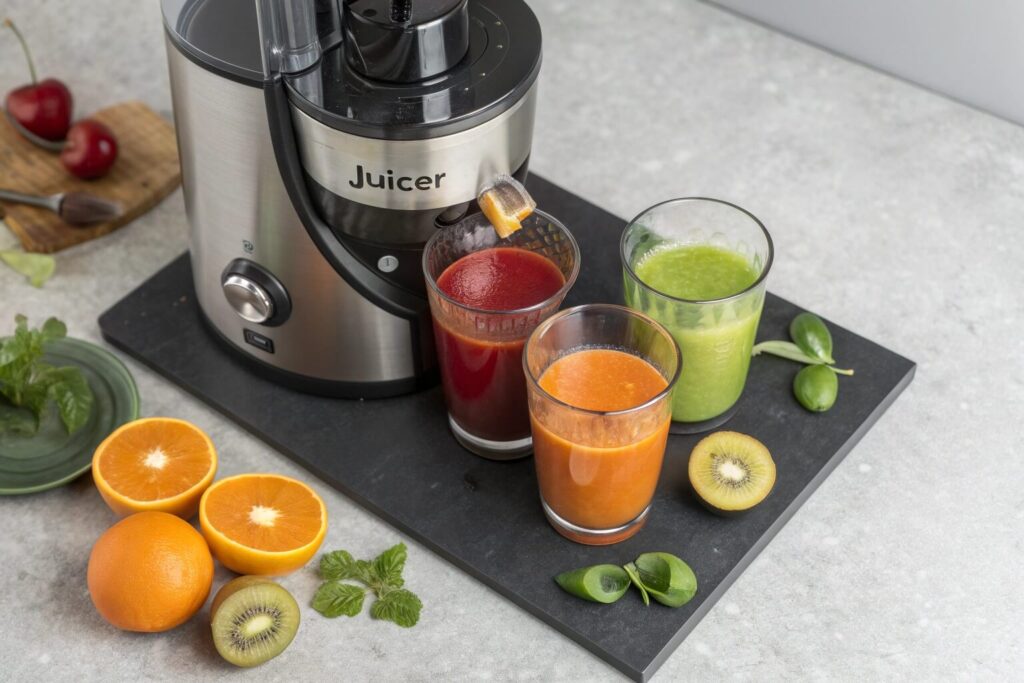
Understanding the Basics
How Juicing Works in General?
Juicing is the process of extracting the liquid content from fruits and vegetables. The goal is to separate the juice (the good stuff) from the fiber and pulp (also good, but not always needed). While traditional juicers use fast-spinning blades, cold press juicers go about it in a more gentle, deliberate way.
Different Types Of Juicers
When looking to add a juicer to your kitchen routine, it is important to understand the different types of juicers available on the market.
There are three main types of juicers:
- Masticating juicers,
- Centrifugal juicers, and
- Cold press juicers.
Masticating juicers grind, crush, and chew fruits and vegetables to extract juice and are best for leafy greens and wheatgrass.
Centrifugal juicers use a fast spinning blade to break down fruits and vegetables and extract juice, and are best for hard fruits and vegetables.
Cold press juicers use a slow, pressing motion and are best for extracting juice from soft fruits and vegetables. Cold press juicers are the most efficient in terms of extracting the most juice out of produce, and are the most popular type of juicer today.
Difference Between Cold Press and Traditional Juicers
Traditional juicers (like centrifugal ones) operate at high speed, which generates heat and causes oxidation. This can degrade nutrients and change the taste. Cold press juicers? They’re the slow and steady tortoises of the juicing world. No heat. No rush. Just pure, clean juice with all the goodness intact.
The Science Behind Cold Press Juicing
What Makes it “Cold”?
Contrary to what some might think, “cold” doesn’t mean the juicer chills your juice. It refers to the absence of heat during the extraction process. Since there’s no fast spinning or blade friction, the juice maintains more of its natural nutrients and enzymes.
The Role of Slow Masticating Technology
At the heart of every cold press juicer is masticating technology. The machine slowly grinds produce using an auger, mimicking the way we chew food. This slow crushing squeezes juice out of the ingredients while preserving flavor, vitamins, and enzymes.
Basic Functionality Of A Cold Press Juicer
Cold press juicers work by slowly crushing and pressing fruits and vegetables to extract their juice. The process is much slower than that of a centrifugal juicer but the resulting juice is much richer in flavor and nutrition.
The basic functionality of a cold press juicer involves a slowly turning auger that crushes the food into a pulp and then squeezes the juice out. It is also equipped with a filter to remove any remaining solids.
The entire process is done at a low temperature, ensuring that the heat from the motor does not affect the flavor or nutritional value of the juice.
Core Components of a Cold Press Juicer
Hopper
This is the top opening where you insert your fruits and veggies. Some juicers have wide hoppers for less prep.
Auger (Masticating Screw)
The auger is the hero here. It rotates slowly to crush and grind the produce into pulp, extracting juice along the way.
Juice and Pulp Outlet
One outlet channels the fresh juice, while another ejects the leftover dry pulp. Efficient separation is key to quality juicing.
Motor Base and Controls
The motor powers the auger, typically running at 40-100 RPM. You’ll usually find basic on/off and reverse controls for jams.
What Is the Mechanism of a Cold Press Juicer?
A cold press juicer, also known as a masticating juicer, works by slowly crushing and pressing fruits and vegetables to extract juice.
Here’s a brief breakdown of the mechanism:
- Slow Rotating Auger: The juicer uses a slow-turning auger (usually around 40–100 RPM) to crush the produce.
- Pressing Against a Strainer: The crushed produce is then pressed against a fine mesh strainer to separate the juice from the pulp.
- Minimal Heat & Oxidation: The slow process generates little heat, preserving more nutrients, enzymes, and flavor compared to high-speed juicers.
This gentle extraction is why it’s called “cold” press—no heat is involved that could degrade nutritional content.
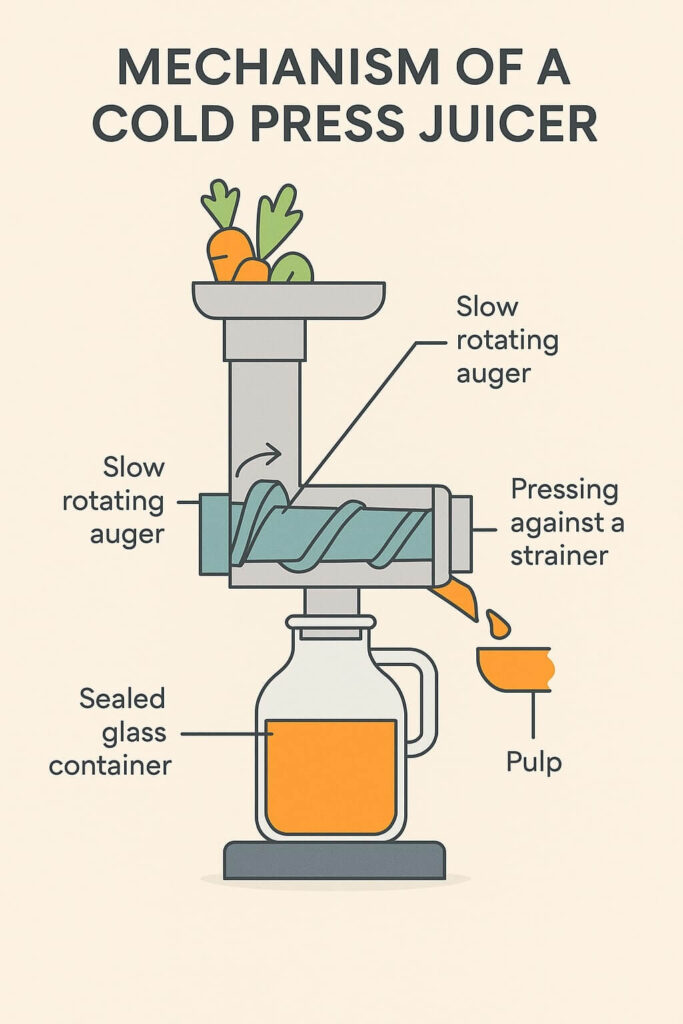
Step-by-Step Process of Cold Press Juicing
Making juice with a cold press juicer is an easy way to get the most out of your produce. To start, prepare the fruits and vegetables and follow the steps mentioned below –

Step 1: Preparing Fruits And Vegetables
After selecting the fruits and vegetables for your cold press juicing, it’s time for preparation. For the most part, you can just rinse the fruits and vegetables under running water. However, some items—such as potatoes, apples, and carrots—may need to be peeled. You should also remove any seeds, pits, or stems that may be present.
Once prepped, cut the fruits and vegetables into small cubes to ensure they can fit through the cold press juicer’s feed chute. If needed, you can also use a grater or a spiralizer if you’re looking for a special texture. After everything is prepped, you’re ready to start your cold press juicing!
Step 2: Feeding the Produce
Once the produce is prepared, assemble the parts of the cold press juicer if they are disassembled. Plug in the juicer, switch it on, and adjust the settings, if necessary. Place the produce into the feeder tube, one piece at a time, and press down with a pusher to activate the augers.
Step 3: Crushing and Pressing
The auger slowly crushes the produce against a mesh screen, squeezing out every drop.
Step 4: Juice Separation
The juice flows through the screen into a collection container, while the pulp is pushed out separately. Most cold press juicers have built-in strainers, but if yours does not, you can strain it with a sieve or nut milk bag.
Step 5: Collecting the Juice and Pulp
Now you have your nutrient-rich juice in one container and dry, reusable pulp in another.
Advantages of Cold Press Juicing
Cold press juicers are a popular choice for making fresh, nutrient-rich juices. These juicers work by pressing produce through a slow-moving auger, which produces less heat and oxidation than traditional juicers. The benifites of cold press juicing are as follows:
Higher Nutrient Retention
Since there’s no heat, vitamins like C and A remain intact, along with live enzymes.
Longer Shelf Life
Cold press juice can stay fresh for up to 72 hours with proper storage, unlike centrifugal juice which oxidizes fast.
Less Foam and Oxidation
Nobody likes frothy juice. Cold press juicing keeps it clean and smooth, with less oxidation and air bubbles.
Save Money
It also assists you to save money in the long run. Though the up-front cost of cold-press juicers are higher than other juicers, you will get 30-35% more yield from them. It is evident that the pulp of cold-pressed juicers is drier than that of centrifugal juicers. As a result, you will save money by purchasing less produce to juice.
Allow Noiseless Operation
Because cold press juicers run slowly and have a lower motor power than centrifugal juicers, they produce much less noise, allowing you to make juice without disturbing other members of your family, particularly children.
Additionally, cold press juicers are easier to clean, making them a convenient option for busy households.
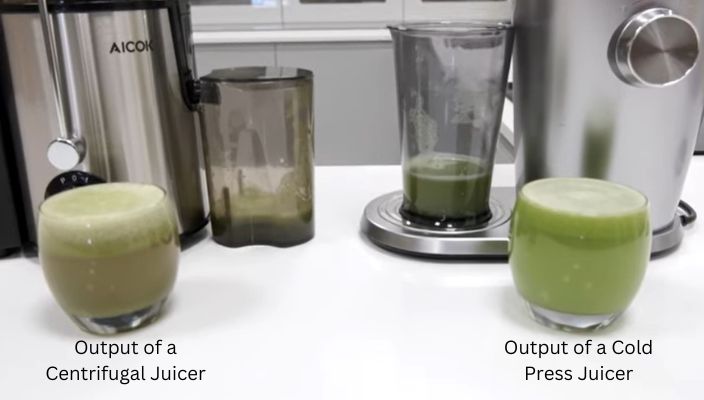
Benefits of cold press juicer at a glance-
- Instead of using quickly spinning blades, it uses a gradual masticating process.
- It separates the juice from the pulp, which is dryer than with other techniques.
- Compared to other juicers, it operates more gently.
- Nutrient loss is minimized, and less foam is produced.
- Compared to other juicers, it is quieter.
- It is simple to maintain and clean.
What are the Disadvantages of a Cold Press Juicer?
Here are some brief disadvantages of cold press juicers:
- Cost – They are generally more expensive than centrifugal juicers.
- Slower Juicing Process – Cold press juicers extract juice more slowly, which can be time-consuming.
- More Prep Work – You often need to cut fruits and vegetables into smaller pieces to fit the chute.
- Heavier and Bulkier – They take up more counter space and are heavier to move or store.
- Cleaning Can Be Tedious – Some models have multiple parts that require thorough cleaning.
Comparing Cold Press to Centrifugal Juicers
Nutrient Comparison
Cold press juicers win here, hands down. They keep more nutrients, making the juice more beneficial for your health.
Noise Levels
Cold press juicers are whisper-quiet compared to the roaring engines of centrifugal juicers.
Ease of Cleaning
They may take a few more minutes to clean, but many come with specialized brushes and dishwasher-safe parts.
Here is a details comparison table between cold press juicers and centrifugal juicers:
| Feature | Cold Press Juicer | Centrifugal Juicer |
|---|---|---|
| Juicing Method | Slow pressing using an auger | High-speed spinning with a blade |
| Speed | Slow (40–100 RPM) | Fast (up to 15,000 RPM) |
| Juice Quality | Higher nutrient retention, less oxidation | Lower nutrient retention, more oxidation |
| Noise Level | Quiet | Loud |
| Suitable for Leafy Greens | Yes | Not very efficient |
| Cleaning | More parts to clean | Fewer parts, easier to clean |
| Price | Generally more expensive | More affordable |
| Juice Shelf Life | Up to 72 hours | Best consumed immediately |
Is Cold Pressed Juice Better than Blender?
Yes, cold-pressed juice is generally considered better than juice made with a blender if you’re aiming for pure juice without fiber.
Here’s a brief comparison:
Cold-pressed juicers extract juice by slowly crushing fruits and vegetables, preserving nutrients and enzymes, and producing a smooth, pulp-free juice.
Blenders mix everything together, including fiber, resulting in a thicker smoothie rather than juice. This can be more filling but may be harder to digest quickly.
In short: Cold-pressed juice is better for nutrient absorption and digestion speed, while blender drinks are better for fiber intake and satiety.
Ideal Fruits and Veggies for Cold Press Juicing
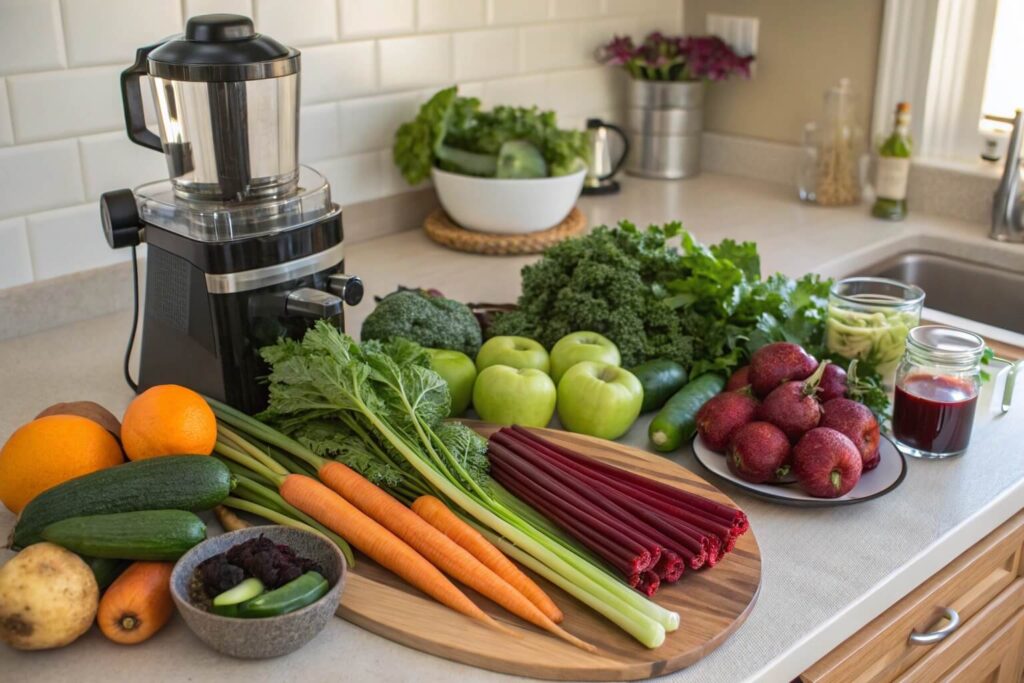
Best Choices for Maximum Juice
- Carrots
- Apples
- Celery
- Kale
- Cucumbers
- Beets
What to Avoid
- Overripe bananas (they’re too mushy)
- Avocados (they don’t juice)
- Stone fruits unless pitted
Can You Put Ginger in a Cold Press Juicer?
Yes, you can put ginger in a cold press juicer. It extracts juice efficiently and adds a strong, spicy kick—just use it in moderation due to its potency.
Tips for Better Juicing Experience
Prepping Produce Properly
Cut ingredients into small chunks. It helps the auger work efficiently and prevents jams.
Layering for Flavor
Mix sweet and earthy ingredients—like apple and beet—for balanced flavors.
Cleaning Hacks
Rinse parts immediately after juicing to prevent residue build-up. A quick soak in warm water goes a long way.
Myths and Misconceptions About Cold Press Juicers
Cold Press Means Cold Juice?
Nope. It means no heat is used in extraction, not that the juice comes out chilled.
They’re Too Slow?
Sure, they’re not speedy—but good things take time, right? The quality is worth the wait.
Who Should Use a Cold Press Juicer?
Health Enthusiasts
Cold press juicing is ideal for those on detoxes or clean eating routines.
Busy Professionals
Make a big batch and store it—morning fuel ready to go!
Families with Kids
Sneak in greens with apple or orange—your kids won’t even notice.
Common Mistakes to Avoid
- Shoving too much produce in at once
- Skipping regular cleaning
- Using ingredients that aren’t meant for juicing
Maintenance and Longevity
Daily Cleaning Tips
Rinse all parts right after use. Don’t let pulp sit and harden.
Deep Cleaning Weekly
Use baking soda and vinegar to scrub down screens and filters.
Storage and Care
Store in a dry area. Don’t wrap cords tightly to avoid motor damage.
Buying Guide for Beginners
What to Look for in a Cold Press Juicer
- Easy to assemble and clean
- High juice yield
- BPA-free parts
Price vs Features
More expensive doesn’t always mean better. Focus on your needs and lifestyle.
Brand Recommendations
Try brands like Hurom, Omega, or Kuvings for long-lasting, high-quality machines.
Conclusion
Cold press juicers are the real deal for anyone serious about juicing. They work slowly and deliberately to give you juice that’s not just fresh, but full of nutrients your body will thank you for. Whether you’re a fitness buff, a busy mom, or just trying to eat (and drink) a little healthier, understanding how a cold press juicer works can change the way you think about juice forever.
FAQs: How Does a Cold Press Juicer Works?
1. Is cold press juice healthier than store-bought?
Absolutely. Store-bought juice is often pasteurized, which kills nutrients. Cold press juice is fresh and loaded with vitamins and enzymes.
2. Can I juice leafy greens with a cold press juicer?
Yes! In fact, they’re excellent for extracting juice from greens like spinach, kale, and wheatgrass.
3. How long does cold press juice last?
Up to 72 hours if stored in a sealed glass container in the fridge.
4. Can kids drink cold press juice?
Definitely. Just keep it balanced and avoid strong flavors like ginger unless they’re used to it.
5. Are cold press juicers worth the money?
If you’re serious about health and juicing regularly, then 100% yes—they’re an investment in wellness.

